United States National Arboretum
|
U.S. National Arboretum | |
 The National Capitol Columns originally supported the old East Portico of the United States Capitol (1828). The columns were removed during expansion of the Capitol in 1958. | |
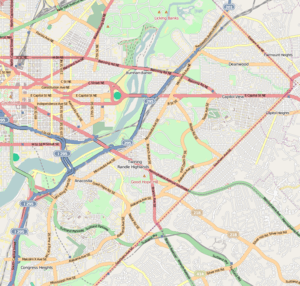 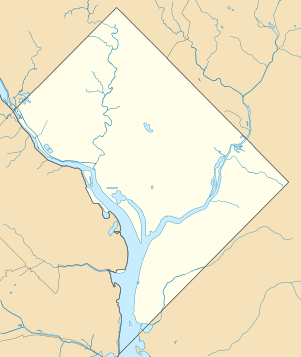  | |
| Location |
24th and R Sts., NE. Washington, D.C. |
|---|---|
| Coordinates | 38°54′36.84″N 76°58′3.14″W / 38.9102333°N 76.9675389°WCoordinates: 38°54′36.84″N 76°58′3.14″W / 38.9102333°N 76.9675389°W |
| NRHP reference # | 73002122 |
| Added to NRHP | April 11, 1973 |
The United States National Arboretum is an arboretum in Washington, D.C., operated by the United States Department of Agriculture's Agricultural Research Service as a division of the Henry A. Wallace Beltsville Agricultural Research Center. It was established in 1927, by an act of Congress after a campaign by USDA Chief Botanist Frederick Vernon Coville.
It is 446 acres (1.80 km2) in size and is located 2.2 miles (3.5 km) northeast of the Capitol building, with entrances on New York Avenue and R Street, Northeast. The campus's gardens and collections are connected by roadways that are nine miles long in total.[1]
The arboretum functions as a major center of botanical research. It conducts research on trees, flowering plants, shrubs and turf, as well as the development of plants.[2] It has a library with 11,000 volumes and approximately 100 publications concentrating in botanical literature.[3]
Gardens/collections
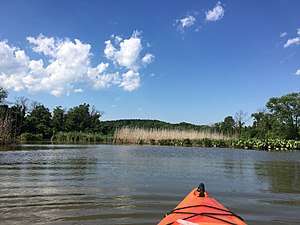

Major garden features
- Aquatic Plants Collection
- Asian Collections
- Japanese Woodland
- Asian Valley
- China Valley
- Korean Hillside
- Classical Chinese Garden (proposed), a 12-acre (4.9 ha) garden designed by a joint team from China and the United States.[4]
- Flowering Tree Collection
- Flowering Tree Walk
- The Friendship Garden and Arbor House
- Arbor House Gift Shop operated by National Capital Area Garden Clubs, Inc.[5]
- Friends of the National Arboretum Office
- National Bonsai Foundation Office
- Gotelli Dwarf and Slow Growing Conifer Collection
- Gotelli & Watnong Collections
- Spruces, Firs, Japanese Maples
- Introduction Garden
- National Bonsai and Penjing Museum
- Japanese, Chinese, North American, and International Pavilions
- National Capitol Columns (see image above)
- National Grove of State Trees, specimens of most of the U.S. state trees
- National Herb Garden
- Historic Roses
- Knot Garden
- Specialty Gardens
- Native Plant Collections ("Fern Valley")
- Fern Valley Woodland
- Prairie
- Southeastern Coastal Plain
Source:[6]
Single-genus groupings
%2C_US_National_Arboretum.jpg)
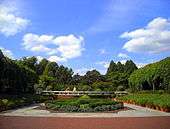
- Azalea Collections
- Glenn Dale Azalea Hillside
- Morrison Garden
- Lee Garden
- Dogwood Collection
- Dogwoods
- Anacostia River Overlook
- Holly Collection
- Magnolia Collection
- Maple Collection
- National Boxwood Collection
- Perennial Collections
- Peony
- Iris
- Daylily
- Daffodil
Source:[6]
Bonsai
The collection includes a Japanese White Pine, (Pinus parviflora 'Miyajima') bonsai tree, donated in 1975 by Masaru Yamaki to mark the US bicentenary. This tree was formerly in Hiroshima, and survived the atomic bomb dropped in that city in 1945. The tree has been "in training" since 1625.[7][8]
Public art
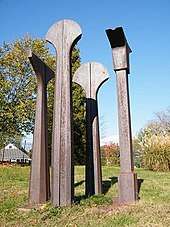
The Arboretum features a small group of public artworks including Split Ritual by American sculptor Beverly Pepper. The piece is made of ductile iron and stands at H. 10 ft (3.0 m) x W. 44 in (110 cm) x D. 100 in (250 cm). It consists of four vertical pieces that look like large tools. They are placed in a circle on top of a doughnut-shaped flat foundation and each tool is unique. The sculpture was dedicated in 1993 and in the same year was surveyed by the Smithsonian's Save Outdoor Sculpture! program and its condition was declared as well maintained.[9]
Gallery
See also
References
- ↑ "Frequently Asked Questions". usna.usda.gov. Retrieved 29 December 2016.
- ↑ "History and Mission". usna.usda.gov. Archived from the original on 23 August 2011. Retrieved 29 December 2016.
- ↑ "U.S. National Arboretum" (PDF). usna.usda.gov. Retrieved 29 December 2016.
- ↑ "A Classical Chinese Garden at the U.S. National Arboretum". usna.usda.gov. Retrieved 29 December 2016.
- ↑ http://www.ncagardenclubs.org/arborhouse.html
- 1 2 "Garden Displays, Collections & Structures". usna.usda.gov. Retrieved 29 December 2016.
- ↑ Siddiqui, Faiz (2 August 2015). "This 390-year-old bonsai tree survived an atomic bomb, and no one knew until 2001 - The Washington Post". The Washington Post. Retrieved 6 August 2015.
- ↑ "US National Arboretum Bonsai Photo Gallery". United States National Arboretum. Retrieved 6 August 2015.
- ↑ Save Outdoor Sculpture! (1993). "Split Ritual, (sculpture)". Save Outdoor Sculpture!. Smithsonian. Retrieved 26 December 2010.
External links
| Wikimedia Commons has media related to United States National Arboretum. |

.jpg)
